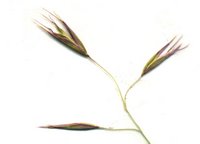 California oatgrass is often cryptic, being low growing with flowering stalks that are typically horizontal near the ground, as if knocked down by a high wind. It forms some the most extensive stands of native grasses on the Preserve, including south of Trail 3 on either side of Rd. F, and in low-lying mesic areas north and south of Global Change site. At the latter site, which includes the vernal pond which provides habitat for California semaphore grass, California oatgrass forms conspicuous tussocks. It has self-fertile (cleistogamous) florets in lower stems stacked upon one another above the stem nodes.
California oatgrass is often cryptic, being low growing with flowering stalks that are typically horizontal near the ground, as if knocked down by a high wind. It forms some the most extensive stands of native grasses on the Preserve, including south of Trail 3 on either side of Rd. F, and in low-lying mesic areas north and south of Global Change site. At the latter site, which includes the vernal pond which provides habitat for California semaphore grass, California oatgrass forms conspicuous tussocks. It has self-fertile (cleistogamous) florets in lower stems stacked upon one another above the stem nodes.
Unlike most other native California grasses mentioned in this blog, which belong to the Pooideae subfamily comprised of mostly Northern Hemisphere, temperate region grasses, Danthonia belongs to the Arundineae Tribe of the Arundinoideae subfamily of Poaceae (subfamily Danthonioideae in the recent Flora of North America's treatment), and has a characteristic field character of that group, namely, ligules of hairs rather than a membrane. Other Arundinoid grasses seen locally include the serious wildland invasives giant reed and Pampas grass. Danthonia, with its long glumes and lemmas awned from the middle of the back, earlier was placed in the Avena Tribe. [The higher level classification of Danthonia has changed again in the Flora of North America.]

Name: for E. Danthoine of France | from California.